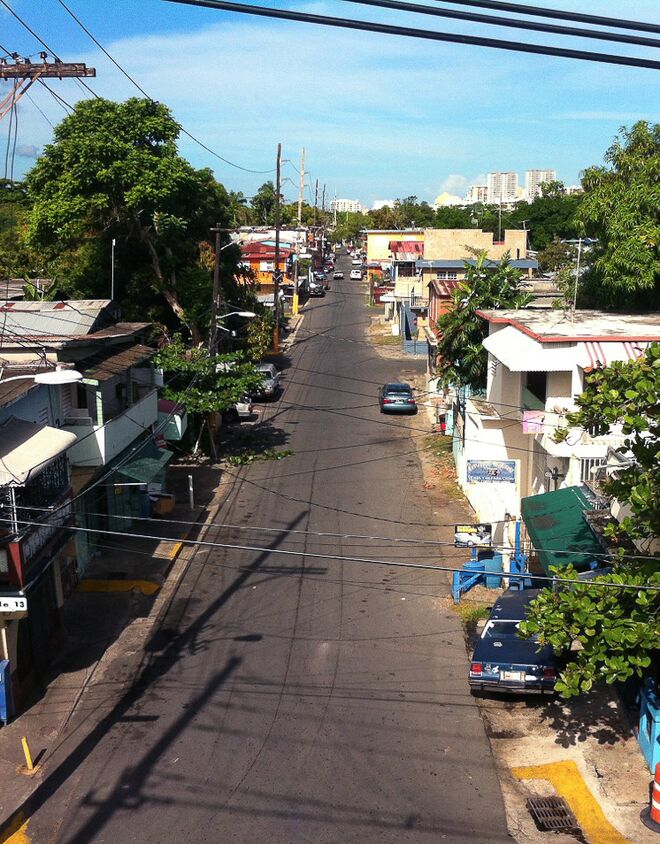19.2. Community Land Trust
Aus Pattern Language Wiki
When seeking to support informal growth patterns, or patterns of affordability, and seeking to apply principles of Land Value Capture, use legal instruments to protect land from excesses of market dynamics, gentrification and displacement.
Problem-statement: One of the biggest drivers of housing cost is often land. This problem is especially acute in urban areas that offer the best opportunities for employment and cultural amenities. For this very reason, however, land for affordable housing often becomes unavailable, or too expensive.
Discussion: The community land trust is a mechanism that allows land to be set aside for housing, preserving a mix of more affordable housing.
One example is The Caño Martín Peña Community Land Trust in Barrio Santurce, a neighborhood of San Juan, Puerto Rico. (It is shown at the start of this pattern.) When market pressures to displace and redevelop their land became enormous, approximately 2,000 families in this poor neighborhood were invited to join a community land trust (CLT) of 80 hectares (200 acres). The CLT protected their homes from displacement, and other public and private programs brought utilities and other necessary upgrades.
Therefore:
When seeking to provide urban land for affordable housing, use the community land trust model where appropriate.
Do not create giant monolithic “affordable” projects, but create neighborhoods of a mix of incomes with “pepper-potting,” maintaining Integrated Affordability…
¹ Examples are discussed in Meehan, J. (2014). Reinventing real estate: The community land trust as a social invention in affordable housing. Journal of Applied Social Science, 8(2), 113-133.
Mehaffy, M. et al. (2020). COMMUNITY LAND TRUST (pattern). In A New Pattern Language for Growing Regions. The Dalles: Sustasis Press. Available at https://pattern-language.wiki/.../Community_Land_Trust
SECTION I:
PATTERNS OF SCALE
1. REGIONAL PATTERNS
Define the large-scale spatial organization…
1.4. 400M THROUGH STREET NETWORK
2. URBAN PATTERNS
Establish essential urban characteristics…
3. STREET PATTERNS
Identify and allocate street types…
4. NEIGHBORHOOD PATTERNS
Define neighborhood-scale elements…
5. SPECIAL USE PATTERNS
Integrate unique urban elements with care…
6. PUBLIC SPACE PATTERNS
Establish the character of the crucial public realm…
7. BLOCK AND PLOT PATTERNS
Lay out the detailed structure of property lines…
8. STREETSCAPE PATTERNS
Configure the street as a welcoming place…
9. BUILDING PATTERNS
Lay out appropriate urban buildings…
10. BUILDING EDGE PATTERNS
Create interior and exterior connectivity…
10.1. INDOOR-OUTDOOR AMBIGUITY
SECTION II:
PATTERNS OF MULTIPLE SCALE
11. GEOMETRIC PATTERNS
Build in coherent geometries at all scales…
11.2. SMALL GROUPS OF ELEMENTS
12. AFFORDANCE PATTERNS
Build in user capacity to shape the environment…
13. RETROFIT PATTERNS
Revitalize and improve existing urban assets …
14. INFORMAL GROWTH PATTERNS
Accommodate “bottom-up” urban growth…
15. CONSTRUCTION PATTERNS
Use the building process to enrich the result…
SECTION III:
PATTERNS OF PROCESS
16. IMPLEMENTATION TOOL PATTERNS
Use tools to achieve successful results…
16.2. ENTITLEMENT STREAMLINING
16.3. NEIGHBORHOOD PLANNING CENTER
17. PROJECT ECONOMICS PATTERNS
Create flows of money that support urban quality…
17.4. ECONOMIES OF PLACE AND DIFFERENTIATION
18. PLACE GOVERNANCE PATTERNS
Processes for making and managing places…
18.3. PUBLIC-PRIVATE PLACE MANAGEMENT
19. AFFORDABILITY PATTERNS
Build in affordability for all incomes…
19.1. INTEGRATED AFFORDABILITY
20. NEW TECHNOLOGY PATTERNS
Integrate new systems without damaging old ones…
20.2. RESPONSIVE TRANSPORTATION NETWORK COMPANY

